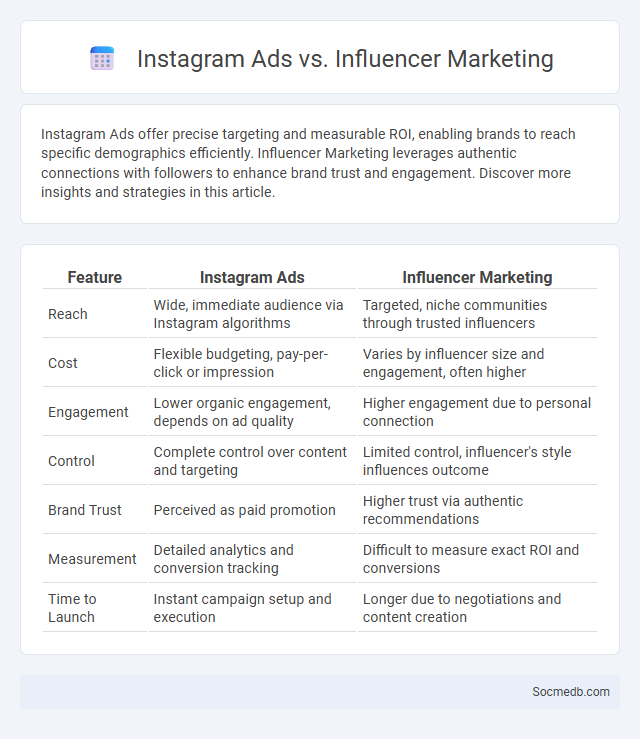
Photo illustration: Instagram Ads vs Influencer Marketing
Instagram Ads offer precise targeting and measurable ROI, enabling brands to reach specific demographics efficiently. Influencer Marketing leverages authentic connections with followers to enhance brand trust and engagement. Discover more insights and strategies in this article.
Table of Comparison
| Feature | Instagram Ads | Influencer Marketing |
|---|---|---|
| Reach | Wide, immediate audience via Instagram algorithms | Targeted, niche communities through trusted influencers |
| Cost | Flexible budgeting, pay-per-click or impression | Varies by influencer size and engagement, often higher |
| Engagement | Lower organic engagement, depends on ad quality | Higher engagement due to personal connection |
| Control | Complete control over content and targeting | Limited control, influencer's style influences outcome |
| Brand Trust | Perceived as paid promotion | Higher trust via authentic recommendations |
| Measurement | Detailed analytics and conversion tracking | Difficult to measure exact ROI and conversions |
| Time to Launch | Instant campaign setup and execution | Longer due to negotiations and content creation |
Introduction: Defining Instagram Ads, Influencer Marketing, and Influencers
Instagram ads are targeted promotional content designed to reach specific audiences through the platform's advanced algorithms and user data. Influencer marketing leverages popular Instagram personalities with large, engaged followings to endorse brands, products, or services authentically. Influencers act as trusted voices in niche markets, creating personalized content that drives consumer engagement and brand awareness.
Audience Targeting Capabilities
Social media platforms offer advanced audience targeting capabilities by utilizing extensive user data, including demographics, interests, behaviors, and location. These targeting options enable marketers to create highly personalized campaigns that reach specific segments with precision, improving engagement and conversion rates. Tools such as Facebook Ads Manager and LinkedIn Campaign Manager leverage machine learning algorithms to continuously optimize ad delivery to the most relevant audience segments.
Cost Comparison: Instagram Ads vs Influencer Marketing
Instagram Ads offer precise targeting options, allowing you to control your budget with costs typically ranging from $0.50 to $2.00 per click, making them a cost-efficient choice for direct conversions. Influencer Marketing often requires higher upfront investment depending on the influencer's reach and engagement, with micro-influencers charging around $100 to $500 per post and top-tier influencers demanding thousands of dollars. Your choice should balance budget constraints with the desired level of authentic audience engagement and brand exposure.
Content Control and Creative Freedom
Social media platforms offer a unique balance between content control and creative freedom, allowing you to tailor your posts while experimenting with innovative formats like stories, reels, and live streams. Algorithms prioritize content that engages your target audience, helping you maximize reach without sacrificing authenticity. Effective use of hashtags, captions, and visual elements empowers your brand's voice to stand out in crowded digital spaces.
Authenticity and Trust Factor
Authenticity on social media enhances user engagement by fostering genuine connections and transparent communication. Building trust through consistent, truthful content increases brand loyalty and positive sentiment among followers. Algorithms favor authentic interactions, amplifying reach and improving overall social media performance.
Measurable ROI and Analytics
Measurable ROI in social media marketing is driven by advanced analytics tools that track engagement rates, conversion metrics, and customer acquisition costs. Leveraging platforms like Google Analytics, Facebook Insights, and Hootsuite enables precise measurement of campaign effectiveness and audience behavior. Data-driven decision-making optimizes budget allocation and maximizes return on investment through targeted content strategies and real-time performance adjustments.
Brand Awareness and Reach Potential
Social media platforms exponentially expand brand awareness by enabling targeted content distribution to diverse audiences, often resulting in viral engagement and increased visibility. Leveraging analytics tools on platforms like Facebook, Instagram, and LinkedIn optimizes reach potential through precise demographic targeting and tailored messaging. Strategic use of hashtags, influencer partnerships, and consistent posting schedules maximizes organic reach, amplifying brand recognition across global markets.
Scalability and Campaign Flexibility
Social media platforms offer unparalleled scalability, allowing businesses to reach millions of targeted users through customizable ad budgets and audience segmentation. Campaign flexibility is enhanced by real-time analytics and A/B testing, enabling marketers to optimize content, adjust strategies, and maximize ROI efficiently. Leveraging features like dynamic ads and multi-platform integration ensures adaptive campaigns that respond to evolving consumer behavior and market trends.
Choosing the Right Strategy for Your Brand
Selecting the right social media strategy involves analyzing your brand's target audience demographics, engagement patterns, and competitors' successful tactics. Prioritize content types that resonate with your followers, such as videos, stories, or user-generated content, to maximize reach and interaction. Consistent performance tracking using analytics tools enables real-time adjustments that enhance brand visibility and conversion rates.
Final Thoughts: Which Option is Best for Your Goals?
Choosing the best social media platform depends on your specific goals, target audience, and content style. Platforms like Instagram excel in visual storytelling, while LinkedIn offers powerful tools for professional networking and B2B marketing. Analyzing user demographics and engagement metrics ensures alignment with your brand objectives and maximizes ROI.
 socmedb.com
socmedb.com